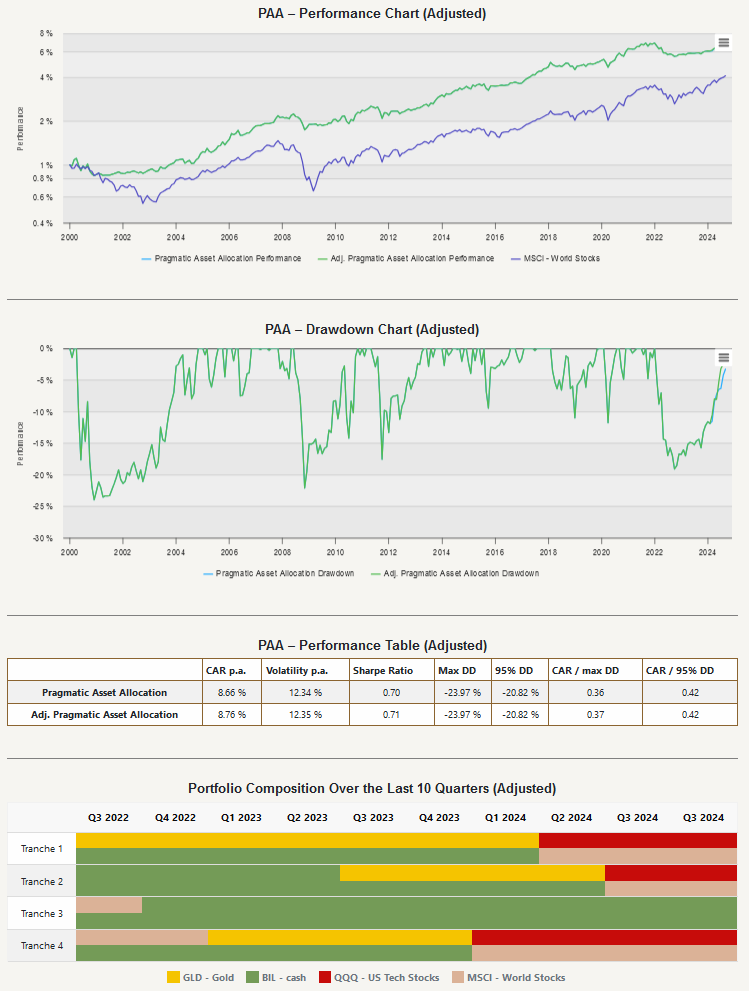
Quantpedia in August 2024
Hello all,
In August, our plan was to build a new “Dashboard” feature on Quantpedia, designed to serve as a centralized hub for subscribers who are just beginning their journey into quantitative trading. The Dashboard provides easy access to key resources, including introductory videos about Quantpedia, a structured study path, and recommended algorithmic trading strategies for beginners. By curating these essential tools in one place, we aim to offer a smoother onboarding experience, guiding users as they explore and deepen their understanding of quantitative research and trading methodologies.
Secondly, based on the readers’ request, we upgraded the Pragmatic Asset Allocation report, in which we will also monitor the adjusted PAA methodology using the amended Yield Curve signal, as outlined in the article A Few Thoughts on Pragmatic Asset Allocation. We assume that in the long run, the performance of both versions will be nearly identical, although individual investments and positions may differ in the short run.

And as usual, let’s also quickly recapitulate Quantpedia Premium development:
- 11 new Quantpedia Premium strategies have been added to our database
- 9 new related research papers have been included in existing Premium strategies during the last month
- 7 new backtests were written in QuantConnect code. Our database currently now contains nearly 800 strategies with out-of-sample backtests/codes.
Additionally, 4 new research articles were published on the Quantpedia blog in the previous month:
Insights from the Geopolitical Sentiment Index made with Google Trends
Authors: Shaun Desai, Dominik Cisar
Title: Insights from the Geopolitical Sentiment Index made with Google Trends
Overnight Reversal Effects in the High-Yield Market
Authors: Cyril Dujava
Title: Overnight Reversal Effects in the High-Yield Market
Lunch Effect in the U.S. Stock Market Indices
Authors: Cyril Dujava
Title: Lunch Effect in the U.S. Stock Market Indices
Payout-Adjusted CAPE
Author: James White and Victor Haghani
Title: Introducing P-CAPE: Incorporating the Dividend Payout Ratio Improves Investors’ Favorite Estimator of Stock Market Returns
Yours …
Radovan Vojtko
CEO & Head of Research
Are you looking for more strategies to read about? Sign up for our newsletter or visit our Blog or Screener.
Do you want to learn more about Quantpedia Premium service? Check how Quantpedia works, our mission and Premium pricing offer.
Do you want to learn more about Quantpedia Pro service? Check its description, watch videos, review reporting capabilities and visit our pricing offer.
Are you looking for historical data or backtesting platforms? Check our list of Algo Trading Discounts.
Would you like free access to our services? Then, open an account with Lightspeed and enjoy one year of Quantpedia Premium at no cost.
Or follow us on:
Facebook Group, Facebook Page, Twitter, Linkedin, Medium or Youtube
Share onLinkedInTwitterFacebookRefer to a friend


















